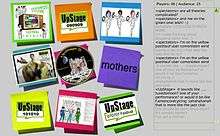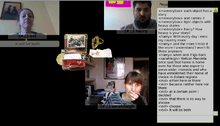UpStage

UpStage is an open source server-side application that has been purpose built for Cyberformance: multiple artists collaborate in real time via the UpStage platform to create and present live theatrical performances, for audiences who can be online (from anywhere in the world) or in a shared space, and who can interact with the performance via a text chat tool. It can also be understood as a form of digital puppetry.
History and context

UpStage was developed during 2003 by programmer Douglas Bagnall, to realise the vision of cyberformance troupe Avatar Body Collision; the group had been creating live performance on the internet using free chat applications such as iVisit and the Palace, and wanted to create an application that better met their artistic needs. The first version of the software was created with a grant from the Smash Palace Collaboration Fund, a joint initiative of Creative New Zealand and the NZ Ministry for Research, Science and Technology; it was launched on 9 January 2004 and began to be used by artists and students around the world, as well as by the originators, Avatar Body Collision.
In 2006, the School of Computing and Mathematical Sciences at the Auckland University of Technology began a relationship with the UpStage project, which has seen teams of final year software development students work on UpStage as a real-world software development project. This has provided invaluable ongoing maintenance and development for the software.
Also in 2006, UpStage received a second grant, this time from the Community Partnership Fund of the New Zealand government's Digital Strategy, which enabled the development of UpStage V2. Douglas Bagnall was once again the lead developer, working this time in conjunction with the AUT students. UpStage V2 was launched in June 2007, with a two-week exhibition at the New Zealand Film Archive and the first UpStage festival, 070707. The festival featured 13 performances by artists from around the world and took place over a 12-hour period on 7 July 2007.
A second festival was held on 080808 (8–9 August 2008), this time covering an 18-hour period and involving artists from at least 14 time zones. It was reviewed in the Australian Stage Online.[1] Following this, festivals were held annually on the successive monthly dates until 121212 (12 December 2012) when the festival extended over a period of one week and included cyberformance in UpStage and other online platforms. A number of works from previous festivals were restaged as a retrospective programme within the festival.
Although "131313" was not possible, the tenth birthday of UpStage was celebrated 13 months after 121212, with a mini-festival of three performances and a meeting to discuss the future of UpStage. At this point, UpStage was unfunded and sustained by volunteers and the (also voluntary) work of the AUT student team. The meeting took place physically in Wellington, New Zealand, and online participants joined via UpStage. Everyone agreed that the project should continue - somehow - and also agreed that the software itself needs to be completely redeveloped, in order to take advantage of newer technologies and be more easily developed and maintained by globally dispersed open source developers.
Features of UpStage

As a web-based server-side application, UpStage can be accessed by both performers and audiences from almost any internet connected computer, using any operating system and browser; computers behind firewalls may require specific ports to be open, and the browser must have the Flash player plug-in as this is used to serve the media to the browser.
"Players" (performers) log into UpStage and have access to a "workshop" or backstage area where they can upload media (graphics and audio), create "stages", and assign media to stages. Once on the stage, a logged-in player has access to numerous tools which allow them to manipulate the media - place, move and speak aloud with graphical avatars (using text2speech), change backdrops, play audio files, draw directly on the stage in real time, add live web cam feeds, use text chat and perform other tasks in order to create and present a performance.
Audience members (also known as "chatters") do not log in - they simply follow a link from an email or another web page, and arrive at the stage which loads as a web page in their browser. They do not see any of the player tools, but they see and hear everything that the players are creating on the stage, and they can chat in the text chat along with the players. Audience chat appears grey and silent, while player chat is black and spoken aloud.
Newcomers (both players and audience) to UpStage can learn the basics very quickly, and the fact that no additional software download is required (unless the Flash player plug-in is not already installed) makes it very accessible. The chat interface encourages playful banter and audience members contribute to and embellish the performance via the chat.
The media used in UpStage performances is created outside of UpStage, using graphic or audio software. Once optimised for Upstage, it is then uploaded via the web interface known as the Workshop and becomes available to everyone who has a log in for that particular UpStage server.
UpStage is an open source project; it can be downloaded from the GitHub site and installed on a web server, giving control over who has log-in access. The interface can also be customised.
Artists using UpStage

Current:
- Ben Unterman & colleagues
- Christina Papagiannouli and Etheatre
- Dan James
- Gabriella Sacco, Floris Sirag and Petyr Veenstra
- Helen Varley Jamieson
- Katarina Djordjevic Urosevic & colleagues
- Miljana Peric
- Vicki Smith
Past (for complete lists of artists who have worked with UpStage, please visit the UpStage web site and browse festival documentation and archives):
- Avatar Body Collision
- ActiveLayers
- Plaintext Players (Antoinette LaFarge & company)
- Marlena Corcoran
- Anaesthesia Associates
- Tara Rebele
- Pauline Bastard
- Nadia Oufrid
- Louise Phillips and Mali & Chad Duckitt
- Marcela Oteiza, Cathia Pagotto & Damla Hacaloglu
- Kristin Carlson & Sheila Page
- Rebekah Wild
- Helena Martin Franco
Further reading

- Francesco Buonaiuto, Helen Varley Jamieson and Vicki Smith, The Net and the Butterfly, published in International Journal of Performance Arts and Digital Media Volume 10 Issue 1, 2014 - special issue on “Interdisciplinary Approaches to Documenting Performance”
- Eliza Bent, Preview of the 121212 UpStage Festival of Cyberformance, American Theatre Magazine, 12 December 2012
- Christina Papagiannouli, Cyberformance and the Cyberstage, published in the International Journal of the Arts in Society, vol 6 issue 4, 2011
- Helen Varley Jamieson and Vicki Smith, UpStage: An Online Tool for Real-Time Storytelling, published in Creative Technologies Journal, Issue 2, November 2011
- Su Ballard & Stella Brennan (eds), The Aotearoa Digital Arts Reader, published by Aotearoa Digital Arts and Clouds, August 2008. ISBN 978-0-9582789-9-7
- Bree Hadley, 080808 UpStage Festival|080808 UpStage Festival, The Australian Stage Online, 9 August 2008
- Helen Varley Jamieson, "UpStage: A Platform for Creating and Performing Online," IEEE MultiMedia, vol. 14, no. 3, pp. 8–10, Jul-Sept, 2007
- Patricia Jung and Helen Varley Jamieson, "Online performances mit UpStage" - chapter in Video: Wiedergabe, Bearbeitung und Streaming unter Linux, ed. Nils Magnus and Torsten Spindler, published by Open Source Press, 2005. ISBN 978-3-937514-10-9
- Patricia Jung, "Performers Go Web", Linux Journal, April 2005;
References
- ↑ Hadley, Bree (2008-08-09). "080808 UpStage Festival". The Australian Stage Online. Retrieved 2008-11-20.
External links
- UpStage web site
- Open UpStage for public performances and events
- UpStage on GitHub - download the application
- We have a situation!